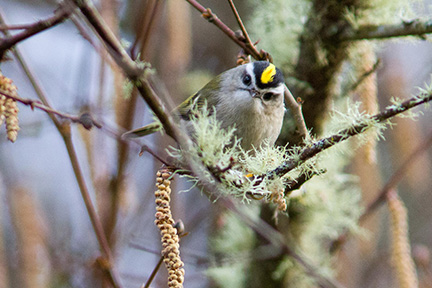 |
Previous Issues |
| Cedar Mill Community Website |
|
Search the Cedar Mill News: |
About The Cedar Mill News |
|
|||||||
| Volume 12, Issue 4 | April 2014 |
||||||
Previous article |
Next article |
|||
Vernal Equinox
|
||||
 |
| Golden-crowned Kinglet with willow catkins. Photo © Jeff Young, 2014 |
In the spring, we also experience the return of various species that spend the summer with us for breeding. These birds spent the past winter in warmer locations to the south. These include the many Swallow species that can be found flying over our yards and ponds plucking insects out of the air.
Another example is the tiny Kinglet family. In some areas in Oregon these may be present year-round. In our local area we tend to see them arrive in the spring and leave in the fall. We have two varieties that come to feast on, for example, the blooming catkins of our willow trees. The Golden-crowned Kinglets are tiny birds with a beautifully striped face and gold on the crown of the head. The Ruby-crowned Kinglets are slightly larger and the red crown is usually not visible unless they are agitated. Both are very active birds that move around a lot in the trees—now is a great time to see them when the trees don’t have leaves.
Anything special I might see in the spring that I won’t see at other times?
The increasing daylight signals to birds that it’s time to produce offspring, so we experience the most active singing of any time of the year. One can often hear the American Robins start up their songs way before the sun rises—even around 3 am or so. Certainly other birds sing to attract mates, to signal their territories, or to ward off invaders. The Red-winged Blackbirds have started to sing in earnest now and most wetland areas are awash with their song, along with the rat-a-tat-tat of the Marsh Wrens and the quacking of the ducks that stay in our area to breed.
Our earliest breeders tend to be Great Horned Owls and Anna’s Hummingbirds. Look for ducklings and goslings around mid April, and newly fledged perching birds such as Robins a bit later. Some birds, such as ducks, are born with downy feathers and others, such as Robins, are born with no feathers and have to stay in the nest for up to two weeks to grow and develop feathers.
You might have noted some different behavior from well-known yard birds such as Bushtits. In the winter they fly around in flocks of up to 40-50 birds and swarm around suet feeders en masse. However in the spring they pair up to build nests and raise young so you may only see one pair at a time at your feeder instead of the large flocks you might be accustomed to seeing.
What can I do to support our bird friends in this time of year?
Keep your outdoor cat inside if at all possible. Cats are the number one threat to newly hatched birds. For example—Chickadee chicks fall out of the their cavity nest and stay on the ground for several hours before they can fly. A wandering cat finds easy prey in such helpless creatures. Also keep some brush around—too tidy a yard leaves nowhere for juveniles to hide from other threats, such as Cooper’s Hawks who feast on other birds, especially juveniles.
Keep feeding the birds—often people think that there are plenty of insects and fruit, but, for example, during a wind storm last year, several thousand swallows died because they couldn’t catch bugs during the spring storm. Keep your feeders clean—hygiene prevents disease spread. Clean up around the base of the feeders often. Put up some bird houses to attract our local cavity nesters such as Chickadees, Nuthatches and Swallows.
Lauretta Young takes all level of birders on customized birding tours in Cedar Mill and beyond. See her website at www.portlandbirdwatching.com. See more of her husband’s photos at flickr.com/photos/youngbirders.
Previous article
![]()
Like us on Facebook for timely updates
Published monthly by Pioneer Marketing & Design
Publisher/Editor:Virginia Bruce
info@cedarmillnews.com
PO Box 91061
Portland, Oregon 97291
© 2013